Buying a used car can save you thousands—but it also comes with risks. Shady sellers, hidden mechanical issues, and sketchy paperwork are all too common. The good news? A little research and the right questions can protect you from getting scammed or stuck with a lemon.
Here are 10 essential tips to help you buy a used car with confidence in 2025.
✅ 1. Set a Realistic Budget (With Wiggle Room)
Don’t just consider the sticker price—factor in:
- Taxes and registration
- Insurance premiums (especially if you’re switching car types)
- Future repairs and maintenance
- A possible pre-purchase inspection
💡 Pro tip: Have an upper limit—and be ready to walk away if a deal pushes it.
🔍 2. Research the Market Value First
Use trusted tools like:
- Kelley Blue Book
- CARFAX Value Range
- AutoTrader’s pricing comparison
This helps you spot overpriced listings or too-good-to-be-true deals.
📄 3. Always Check the Vehicle History Report
This is non-negotiable. A full report reveals:
- Past accidents or flood damage
- Odometer rollback
- Ownership and title history
- Service records and recalls
Use CARFAX, AutoCheck, or request a VIN history from the seller.
🛠️ 4. Get a Pre-Purchase Inspection (PPI)
Before handing over any money, have the car inspected by an independent mechanic.
They’ll check for:
- Leaks or hidden rust
- Engine and transmission wear
- Brake and suspension condition
📌 Even if the seller says it was “just serviced,” always double-check.
📞 5. Communicate Clearly—and Watch for Red Flags
Beware of:
- Sellers unwilling to meet in person
- Pressure to wire money or pay with gift cards
- Vague answers about the car’s history
- “Too urgent” deals (“It’s going tomorrow unless you buy now!”)
🚩 Trust your gut. If it feels sketchy, it probably is.
📷 6. Inspect the Car Thoroughly Yourself
Check:
- Tires: Even tread? Matching brands?
- Paint: Look for color mismatches or signs of body filler.
- Interior wear: Does it match the odometer reading?
- Under the hood: Signs of leaks, cracked belts, or corrosion?
📷 Take photos and notes—you’ll thank yourself later.
🚘 7. Always Take a Test Drive
Try to drive in various conditions:
- Highway and city
- Sharp turns
- Hills if possible
Pay attention to:
- Strange noises
- Shaky steering
- Dashboard warning lights
👂 Turn off the radio and listen to the car itself.
📝 8. Verify the Title Is Clean and Transferable
The seller must have the legal title in their name—no exceptions.
Check for:
- Liens (is the car still financed?)
- Salvage or rebuilt status
- Correct VIN on paperwork and the vehicle
🛑 If they say they “lost the title” or are selling “for a friend,” walk away.
💵 9. Use a Safe and Secure Payment Method
Avoid:
- Cash-only deals with no receipt
- Wire transfers
- Paying before you see the car
✅ Best practice: Meet at your bank to make a secure certified payment.
🧾 10. Don’t Skip the Bill of Sale
A written bill of sale should include:
- Full names and contact info
- Vehicle details (make, model, VIN)
- Final agreed price
- Date of sale
- Both parties’ signatures
This protects you legally and financially.
🚙 Bonus Tip: Consider Buying Certified Pre-Owned (CPO)
If you’re nervous about private sales, a CPO vehicle from a dealer may be worth the extra cost. It typically includes:
- Multi-point inspection
- Limited warranty
- Return policy
✅ Final Thoughts
Buying a used car doesn’t have to be risky. With a clear plan, proper paperwork, and a little due diligence, you can drive away with peace of mind and money saved. Take your time, trust your instincts, and never let a seller rush your decision.


